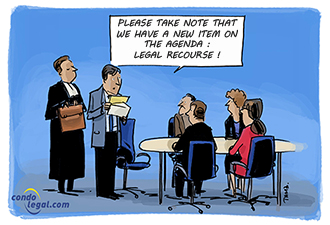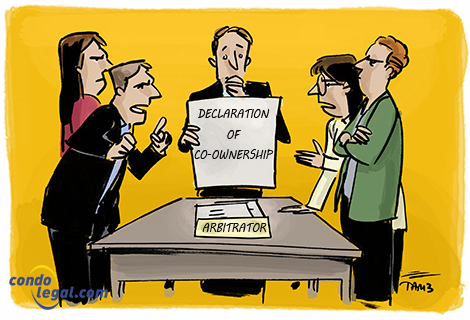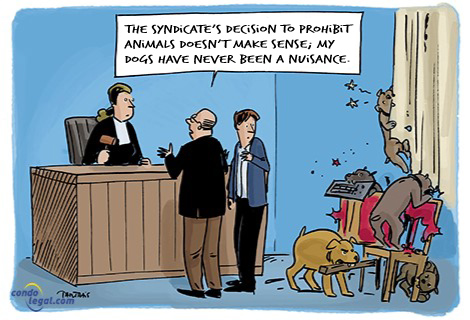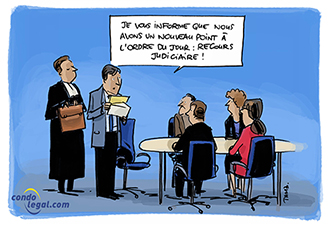Legal recourse against a syndicate of co-owners

Initiating legal proceedings against a syndicate of co-owners is a measure of last resort, after having unsuccessfully explored private dispute prevention and resolution process. This path requires careful preparation and a thorough knowledge of the rules of law. This fact sheet is designed to guide those who are considering going to court to resolve their dispute with a syndicate of co-owners, by highlighting the legal basis and typical situations that can lead to such legal action. It is essential to approach this step with due diligence and a clear understanding of your legal rights and obligations.
Nature of legal remedies
There are several types of legal recourse against a syndicate of co-owners, varying according to the litigation and the goals pursued by the co-owners who initiated the process. The following is a list of the main categories of legal remedies:
- Civil liability claims: A syndicate of co-owners is likely to incur civil liability towards third parties, including co-owners. This liability may result from various breaches, such as faulty design or construction defects, a lack of maintenance of the common portions, or the wrongful actions of its employees or directors. This type of recourse is initiated when the actions or negligence of the syndicate cause harm to the co-owners or third parties. This may include property damage, disturbance of enjoyment or financial loss resulting from, for example, a lack of maintenance of the common portions.
- Recourse for non-compliance with the declaration of co-ownership: When the board of directors fails to meet its obligations defined by the declaration of co-ownership, particularly with regard to the second part, i.e. the rules of the building, the co-owners may take action against the syndicate to force it to comply with the terms of this document. The objective of this process is to obtain a court injunction order forcing the syndicate to enforce the clauses of the declaration of co-ownership.
- Application for injunction: Co-owners can apply for an injunction to force the syndicate to perform or cease specific actions. This may concern the immediate cessation of noise pollution generated by defective common equipment or the obligation to carry out work in the common portions to prevent damage.
- Recourse to annul or modify a decision of a decision of the meeting of co-owners: If a co-owner considers that a decision taken at a meeting of co-owners has been adopted in violation of the rules of co-ownership or the law in force, he may ask the court to annul or, exceptionally, to modify this decision. The causes for the court's intervention are the following: bias in a decision, intent to injure co-owners, disregard of the rights of co-owners or an error in the calculation of votes. This legal remedy is provided for in article 1103 of the Civil Code of Québec. An application against a decision of the meeting of co-owners must, on pain of forfeiture, be filed within 90 days of the decision.
- Recourse to annul or modify a decision of the board of directors: If a co-owner or administrator considers that a decision taken at a meeting of the board of directors was adopted in violation of the rules of the co-ownership or the law in force, he or she may ask the court to annul this decision. The causes for the court's intervention are the following: bias in a decision, intent to injure co-owners, disregard of the rights of co-owners. This legal remedy is provided for in article 1086.2 of the Civil Code of Québec. An application against a decision of the board of directors must, on pain of forfeiture, be filed within 90 days of the decision.
- Recourse for review and modification of the relative value of a fraction and the distribution of charges: Each co-owner can apply to the court to have the relative value of the fractions and the distribution of common charges reviewed. This legal remedy is provided for in article 1068 of the Civil Code of Québec. To be admissible, it must be initiated within a maximum period of five years following the registration date (in the Land register) of the declaration of co-ownership and must meet specific criteria.
Drafting and filing the application
If an amicable resolution proves impossible or ineffective, the next step is to file a claim with the competent court. This step includes:
- Legal Procedure: It is essential to gather all relevant evidence. This includes correspondence with the syndicate, testimonies from co-owners or third parties, expert reports, photos, etc. A legal action is brought by means of a written procedure called an "originating application". The request must briefly describe the facts motivating the procedure and state the conclusions, whether they are financial or otherwise.
- Determination of the competent jurisdiction: Depending on the amount of the dispute and the nature of the case, the competent court may vary (Court of Québec (Civil division or Small claims division) or Superior court of Québec).
- Payment of court fees: The filing of the application is subject to court fees, the amount of which varies. They include, in particular, court fees and the costs of service of court proceedings by a bailiff. Court costs are usually awarded to the party in whose favour the judgment is rendered.
Follow-up of the procedure
Once the application has been filed, the legal proceedings continue. This includes:
- Summons: The syndicate of co-owners is officially notified of the application by a notice of summons and is summoned to appear in court. This notice will inform him, among other things, of the deadline within which he must file his response and the consequences to which he is exposed if he does not respond within this period.
- Notice to co-owners: Within five days of service of the originating application, the syndicate is required to notify all the co-owners, indicating the subject of the application.
- Answer: Upon receipt of the originating application and the notice of summons by the bailiff, if your syndicate wishes to contest the application, it has 15 days to file a response through its legal representative (in the case of an action instituted before the Small Claims Division of the Court of Québec) or in other cases by the lawyer it designates. In its response, the syndicate will have to indicate: either that it wishes to agree to a settlement of the matter, or that it wishes to contest the application and establish a protocol of proceedings with the plaintiff, or that it proposes mediation or a settlement conference. Failure to do so will result in the continuation of the proceedings in his absence, and a judgment may be pronounced against the syndicate without the syndicate having had an opportunity to defend itself.
- Defence: As a defendant, the syndicate of co-owners may set out in its defence all the legal or factual elements which it may contest the legal action brought against it. An example of a point of law that may be raised is the lateness of the action. This may be the case, in particular, for the forfeiture period relating to the recourse for annulment of the decisions of the board of directors or the meeting of co-owners or a right prescribed by the lapse of time.
- The trial: During the hearing, the parties present their arguments orally in front of the judge, who may also ask questions to clarify certain points.
Judgment
After deliberation, the court renders its judgment either in favor of the plaintiff (by granting his claim) or in favor of the defendant (by dismissing the plaintiff's claim). It may also happen that the judge agrees with the plaintiff only on certain points. This judgment may be subject to appeal, in some cases, in the event of disagreement by one of the parties.
 WHAT YOU SHOULD KNOW ! A notice of summons does not require directors to appear in person at the courthouse. Instead, he asked the syndicate to produce a document in the court file called a response. It is highly recommended that you consult a lawyer who specializes in co-ownership law. This professional will be able to assess the strength of your case and advise you on the best way to proceed.
WHAT YOU SHOULD KNOW ! A notice of summons does not require directors to appear in person at the courthouse. Instead, he asked the syndicate to produce a document in the court file called a response. It is highly recommended that you consult a lawyer who specializes in co-ownership law. This professional will be able to assess the strength of your case and advise you on the best way to proceed.
 WHAT TO KEEP IN MIND: Before embarking on legal proceedings, attempting an amicable resolution can be beneficial. Mediation can resolve the dispute without having to go to court. This method of dispute resolution consists of attempting to settle a dispute by calling on a neutral third party, in this case the mediator. This is a voluntary process involving both parties in disagreement. Its main objective is to facilitate exchanges in order to defuse the conflict and find common ground.
WHAT TO KEEP IN MIND: Before embarking on legal proceedings, attempting an amicable resolution can be beneficial. Mediation can resolve the dispute without having to go to court. This method of dispute resolution consists of attempting to settle a dispute by calling on a neutral third party, in this case the mediator. This is a voluntary process involving both parties in disagreement. Its main objective is to facilitate exchanges in order to defuse the conflict and find common ground.
 WARNING ! Often, the declaration of co-ownership provides that any dispute with the syndicate must be resolved through mediation or arbitration, effectively excluding the possibility of taking the matter to court. It is therefore advised to check the provisions of your declaration of co-ownership to avoid having your legal action dismissed by the court, which could then require the parties to settle their dispute through mediation or arbitration.
WARNING ! Often, the declaration of co-ownership provides that any dispute with the syndicate must be resolved through mediation or arbitration, effectively excluding the possibility of taking the matter to court. It is therefore advised to check the provisions of your declaration of co-ownership to avoid having your legal action dismissed by the court, which could then require the parties to settle their dispute through mediation or arbitration.
. Back to the factsheets

 WHAT YOU SHOULD KNOW ! A notice of summons does not require directors to appear in person at the courthouse. Instead, he asked the syndicate to produce a document in the court file called a response. It is highly recommended that you consult a lawyer who specializes in co-ownership law. This professional will be able to assess the strength of your case and advise you on the best way to proceed.
WHAT YOU SHOULD KNOW ! A notice of summons does not require directors to appear in person at the courthouse. Instead, he asked the syndicate to produce a document in the court file called a response. It is highly recommended that you consult a lawyer who specializes in co-ownership law. This professional will be able to assess the strength of your case and advise you on the best way to proceed. WHAT TO KEEP IN MIND: Before embarking on legal proceedings, attempting an amicable resolution can be beneficial. Mediation can resolve the dispute without having to go to court. This method of dispute resolution consists of attempting to settle a dispute by calling on a neutral third party, in this case the mediator. This is a voluntary process involving both parties in disagreement. Its main objective is to facilitate exchanges in order to defuse the conflict and find common ground.
WHAT TO KEEP IN MIND: Before embarking on legal proceedings, attempting an amicable resolution can be beneficial. Mediation can resolve the dispute without having to go to court. This method of dispute resolution consists of attempting to settle a dispute by calling on a neutral third party, in this case the mediator. This is a voluntary process involving both parties in disagreement. Its main objective is to facilitate exchanges in order to defuse the conflict and find common ground. WARNING ! Often, the declaration of co-ownership provides that any dispute with the syndicate must be resolved through mediation or arbitration, effectively excluding the possibility of taking the matter to court. It is therefore advised to check the provisions of your declaration of co-ownership to avoid having your legal action dismissed by the court, which could then require the parties to settle their dispute through mediation or arbitration.
WARNING ! Often, the declaration of co-ownership provides that any dispute with the syndicate must be resolved through mediation or arbitration, effectively excluding the possibility of taking the matter to court. It is therefore advised to check the provisions of your declaration of co-ownership to avoid having your legal action dismissed by the court, which could then require the parties to settle their dispute through mediation or arbitration.







